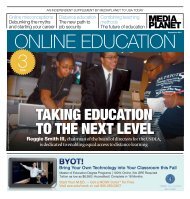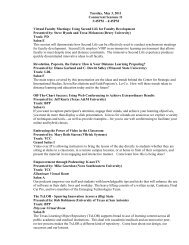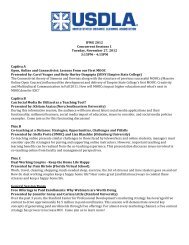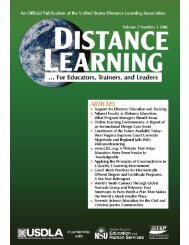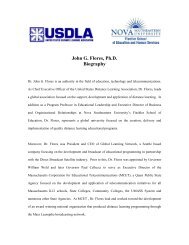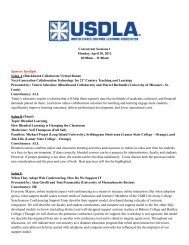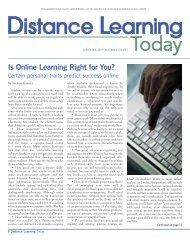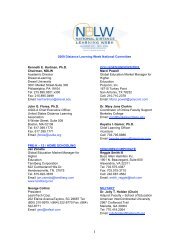United States Distance Learning Association
United States Distance Learning Association
United States Distance Learning Association
- No tags were found...
You also want an ePaper? Increase the reach of your titles
YUMPU automatically turns print PDFs into web optimized ePapers that Google loves.
artifacts) that demonstrates a person's<br />
expansion of knowledge and skills over<br />
time. The contents, organization, and presentation<br />
of materials in a portfolio vary<br />
greatly, depending on its audience (e.g.,<br />
employer or faculty advisor), purpose (e.g.,<br />
to get a job versus to demonstrate a masters<br />
degree requirement), and type (e.g.,<br />
showcase or employment portfolio). Digital<br />
portfolios, sometimes referred to as<br />
electronic portfolios, e-folios, multimedia<br />
portfolios, Webfolios and electronicallyaugmented<br />
portfolios, contain much of the<br />
same content as regular, traditional portfolios,<br />
but their materials are produced and<br />
shared in digital format such as a Web site<br />
(Kilbane & Milman, 2003, 2005). As a result,<br />
digital portfolios are not merely a number<br />
of artifacts or lists of experiences put onto<br />
the Web without a specific goal and ability<br />
to demonstrate reflection. A digital portfolio<br />
is not an electronic résumé. What distinguishes<br />
it from one is that it contains<br />
thoughtful, professional, reflective comments<br />
about its contents.<br />
WHAT IS THE DIGITAL PORTFOLIO<br />
DEVELOPMENT PROCESS<br />
Embarking on the creation of a digital portfolio<br />
is similar to going on a journey. It is a<br />
journey that will take you places you may<br />
not have otherwise visited (i.e., creation of<br />
a portfolio), or places you have not visited<br />
in some time (e.g., your résumé that<br />
requires updating, some wrinkled letters<br />
from a colleague, professor, or employer<br />
complimenting you on your work, or an<br />
old PowerPoint presentation you created<br />
years ago). The fun part about taking this<br />
journey is having other people to experience<br />
the new sights and adventures with<br />
you. So, I encourage you to find some critical<br />
friends, people you know will give you<br />
constructive feedback about your portfolio<br />
and who might develop their own portfolios<br />
along with you. This will provide you<br />
with a community of critical friends so that<br />
you may lean on each other, both for direction<br />
in this journey as well as encouragement,<br />
advice, ideas, critiques, help, and<br />
camaraderie.<br />
WHY DEVELOP A<br />
DIGITAL PORTFOLIO<br />
There are many reasons why you (or your<br />
students) might develop a digital portfolio.<br />
Among the many reasons for developing<br />
one are that they provide an easy and efficient<br />
way to showcase your knowledge<br />
and professionalism with many people<br />
simultaneously (there is no need to tote<br />
around a heavy binder of materials from<br />
person to person!), update portfolio materials<br />
effortlessly and cheaply, illustrate<br />
much sought-after technology skills, and<br />
control your “message.” Academic programs<br />
within institutions can benefit as<br />
well from digital portfolios. For example, a<br />
program can highlight information about<br />
its courses and degree areas that demonstrate<br />
its quality and validate student competency,<br />
while also providing a marketing<br />
tool.<br />
OVERVIEW OF THE STEPS IN THE<br />
DIGITAL PORTFOLIO PROCESS<br />
Before creating a digital portfolio, it is<br />
important to understand the five basic<br />
stages in the development of a portfolio<br />
(Kilbane & Milman, 2003), each consisting<br />
of several distinct processes or steps. They<br />
are:<br />
Planning the portfolio. Focus on the<br />
goals of your portfolio and frame its objectives.<br />
Focusing your portfolio involves<br />
identifying the purpose(s) for and<br />
intended audience(s) of your portfolio,<br />
whereas framing your portfolio entails creating<br />
continuity among the various components<br />
of your portfolio.<br />
Considering portfolio contents. Collect,<br />
select, and reflect on the materials you will<br />
include in your portfolio. In the beginning<br />
of this stage, the emphasis is on quantity<br />
(e.g., collecting as many artifacts as possible),<br />
and then on quality (e.g., selecting the<br />
94 <strong>Distance</strong> <strong>Learning</strong> Volume 4, Issue 4



